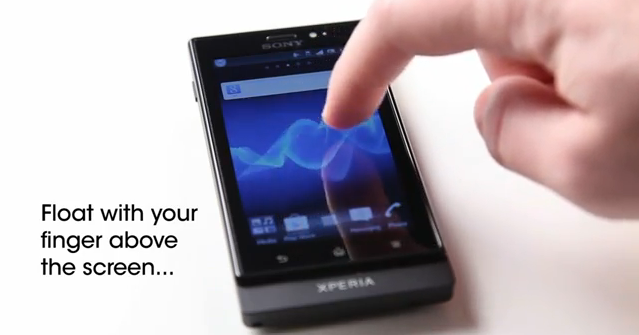
Earlier today Sony announced the new Xperia Sola smartphone. It joins the Xperia S, U and P models, sitting nicely between the U and P in the range with decent but not ground-breaking specifications.
The Xperia Sola caught our eye though, because Sony tells us it is the first smartphone to feature a new piece of technology called ‘Floating Touch’. This tech means that the user can control the phone by hovering their finger above the screen – not by touching it.
The technology is technically in its infancy as far as smartphones are concerned, but Sony tells us you can hover your finger above the screen to manipulate an interactive wallpaper, and to scroll through lists and menus in the phone’s web browser. We’ve become very accustomed to using touchscreen devices, so how on earth does this phone respond to your fingers hovering above it, not touching anything at all?
Erik Hellman, Research Engineer at Sony, has kindly explained how this wizardry works. It all starts with using two types of capacitive touch sensor on one screen in order to deal with regular touch and the hovering interaction used with Floating Touch. There are two types of capacitive sensors that can be used in a mobile phone’s touchscreen, Self-Capacitance and Mutual-Capacitance. Typically a manufacturer would use one – usually Mutual-Capacitance sensors as they provide a more accurate multi-touch response.
However, Self-Capacitance sensors are much larger and provide a stronger signal, which means they are able to detect the presence of your finger from further away – up to 20mm away from the screen in fact. If Sony was to build a smartphone using only these sensors it would sacrifice multi-touch – something that is key to a modern smartphone, especially an Android one. This means the screen on the Xperia Sola would need to use both sensors, something that hasn’t been done before on any phone.
Using both types of capacitive touch sensor is exactly what Sony did, laying two grids of sensors beneath the 3.7-inch screen panel of the Xperia Sola. Mutual-Capacitance sensors take care of multi-touch gestures performed on the screen itself, while Self-Capacitance sensors are able to detect your finger up to 20mm above the screen, which means you can scroll through lists and manipulate objects like the default background, which either moves by itself or when you move it with your finger.
Not all apps on the Xperia Sola will work with the Floating Touch technology, and currently the only implementations of it we’ve seen are in the native browser and with the wallpaper. Sony has created an API for the Android 4.0 update that will land in summer, offering developers the chance to bake Floating Touch features into their own apps.
We’re certainly impressed with Floating Touch and the Xperia Sola, and can’t wait to try it out for ourselves. Who knows where this technology could lead?
Let us know your thoughts on our comments below or via our @Gadget_Helpline Twitter page or Official Facebook group.
Source: Sony
